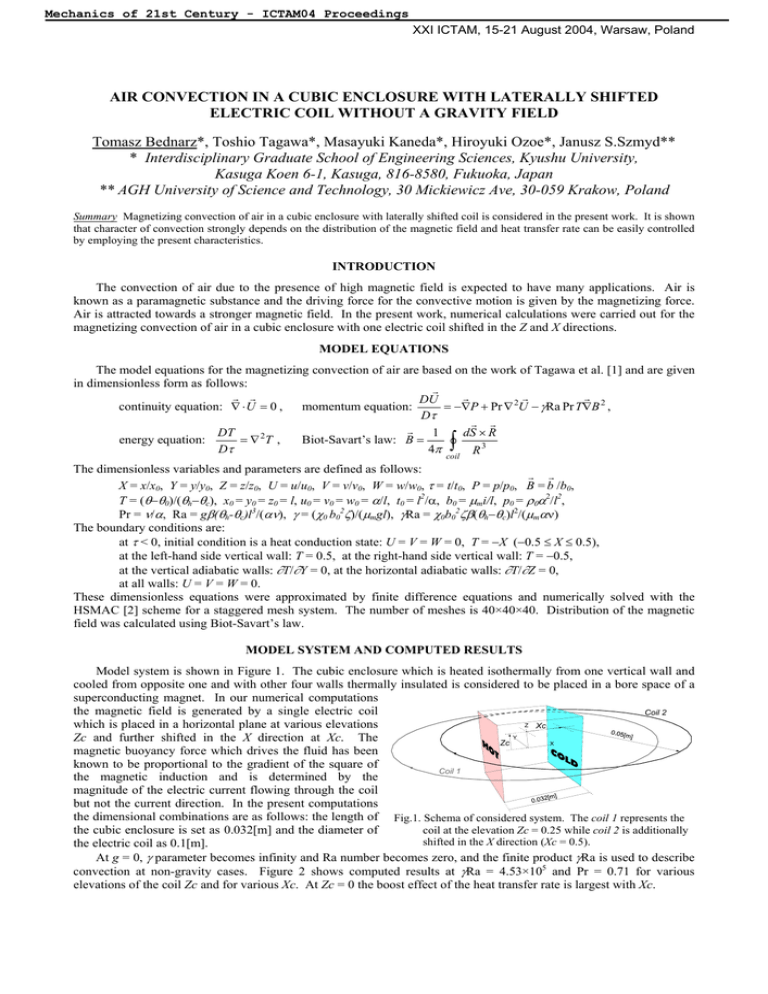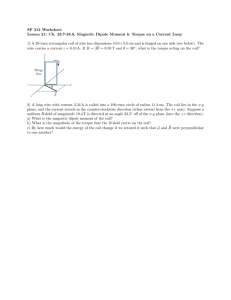Tomasz Bednarz*, Toshio Tagawa*, Masayuki Kaneda*, Hiroyuki Ozoe*, Janusz S.Szmyd**
advertisement

Mechanics of 21st Century - ICTAM04 Proceedings XXI ICTAM, 15-21 August 2004, Warsaw, Poland AIR CONVECTION IN A CUBIC ENCLOSURE WITH LATERALLY SHIFTED ELECTRIC COIL WITHOUT A GRAVITY FIELD Tomasz Bednarz*, Toshio Tagawa*, Masayuki Kaneda*, Hiroyuki Ozoe*, Janusz S.Szmyd** * Interdisciplinary Graduate School of Engineering Sciences, Kyushu University, Kasuga Koen 6-1, Kasuga, 816-8580, Fukuoka, Japan ** AGH University of Science and Technology, 30 Mickiewicz Ave, 30-059 Krakow, Poland Summary Magnetizing convection of air in a cubic enclosure with laterally shifted coil is considered in the present work. It is shown that character of convection strongly depends on the distribution of the magnetic field and heat transfer rate can be easily controlled by employing the present characteristics. INTRODUCTION The convection of air due to the presence of high magnetic field is expected to have many applications. Air is known as a paramagnetic substance and the driving force for the convective motion is given by the magnetizing force. Air is attracted towards a stronger magnetic field. In the present work, numerical calculations were carried out for the magnetizing convection of air in a cubic enclosure with one electric coil shifted in the Z and X directions. MODEL EQUATIONS The model equations for the magnetizing convection of air are based on the work of Tagawa et al. [1] and are given in dimensionless form as follows: r r r r r r DU momentum equation: = −∇P + Pr ∇ 2U − γRa Pr T∇B 2 , continuity equation: ∇ ⋅ U = 0 , Dτ r r r dS × R DT 1 2 energy equation: =∇ T , Biot-Savart’s law: B = Dτ 4π R3 ∫ coil The dimensionless variables and parameters are defined as follows: r r X = x/x0, Y = y/y0, Z = z/z0, U = u/u0, V = v/v0, W = w/w0, τ = t/t0, P = p/p0, B = b /b0, T = (θ−θ0)/(θh−θc), x0 = y0 = z0 = l, u0 = v0 = w0 = α/l, t0 = l2/α, b0 = µmi/l, p0 = ρ0α2/l2, Pr = ν/α, Ra = gβ(θh-θc)l3/(αν), γ = (χ0 b02ζ)/(µmgl), γRa = χ0b02ζβ(θh−θc)l2/(µmαν) The boundary conditions are: at τ < 0, initial condition is a heat conduction state: U = V = W = 0, T = −X (−0.5 ≤ X ≤ 0.5), at the left-hand side vertical wall: T = 0.5, at the right-hand side vertical wall: T = −0.5, at the vertical adiabatic walls: ∂T/∂Y = 0, at the horizontal adiabatic walls: ∂T/∂Z = 0, at all walls: U = V = W = 0. These dimensionless equations were approximated by finite difference equations and numerically solved with the HSMAC [2] scheme for a staggered mesh system. The number of meshes is 40×40×40. Distribution of the magnetic field was calculated using Biot-Savart’s law. MODEL SYSTEM AND COMPUTED RESULTS Model system is shown in Figure 1. The cubic enclosure which is heated isothermally from one vertical wall and cooled from opposite one and with other four walls thermally insulated is considered to be placed in a bore space of a superconducting magnet. In our numerical computations the magnetic field is generated by a single electric coil Coil 2 Z Xc which is placed in a horizontal plane at various elevations Y Zc and further shifted in the X direction at Xc. The X Zc magnetic buoyancy force which drives the fluid has been known to be proportional to the gradient of the square of Coil 1 the magnetic induction and is determined by the magnitude of the electric current flowing through the coil but not the current direction. In the present computations the dimensional combinations are as follows: the length of Fig.1. Schema of considered system. The coil 1 represents the coil at the elevation Zc = 0.25 while coil 2 is additionally the cubic enclosure is set as 0.032[m] and the diameter of shifted in the X direction (Xc = 0.5). the electric coil as 0.1[m]. At g = 0, γ parameter becomes infinity and Ra number becomes zero, and the finite product γRa is used to describe convection at non-gravity cases. Figure 2 shows computed results at γRa = 4.53×105 and Pr = 0.71 for various elevations of the coil Zc and for various Xc. At Zc = 0 the boost effect of the heat transfer rate is largest with Xc. Mechanics of 21st Century - ICTAM04 Proceedings XXI ICTAM, 15-21 August 2004, Warsaw, Poland Average Nusselt Number [-] 5.5 The average Nusselt number 1.678 at Xc = −0.5 increases to 5.0 5.17 at Xc = 0.75. At Zc = 0.25 and 0.5 the character of the plots is alike and the local minimum of the average Nusselt 4.5 number is observed at Xc = −0.5 and maximum at Xc = 0.75. Zc = 0.5 4.0 Zc = 0.75 When the coil is placed in a horizontal plane in a distance Zc = 3.5 1.0 from the mid-plane (Z=0), the average Nusselt varies from 3.025 to 3.205. Computed results show that the heat transfer 3.0 Zc = 0.25 Zc = 1.0 rate can be significantly increased especially with the coil 2.5 shifted close to the left-hand side vertical hot wall. Zc = 0 2.0 Figure 3 shows two extreme cases: the upper ones at 1.5 Xc = −0.75 and the lower ones at Xc = 0.75, both at the same value of Zc = 0. The coil is placed in a horizontal plane in -0.75 -0.50 -0.25 0.00 0.25 0.50 0.75 both cases at Z = 0 and only difference is in the coil’s position: Xc [-] once the coil is closer to the right-hand side cold wall Fig.2. The average Nusselt numbers versus the Xc parameter at various elevations Zc at Pr = 0.71, (Xc = −0.75) and another closer to the left-hand side hot γRa = 4.53×105 without a gravity field. wall (Xc = 0.75). At Xc = −0.75 the magnetic buoyancy force vectors seen in Figure 3(b) have larger magnitude close to the cold wall. The force in this region is acting to attract the colder air toward the coil’s wire with accordance to the gradient of the square of the magnetic induction and proportionally to local temperature. As seen in Figure 3(d) the colder air is going downward along the cold wall in the upper part of the enclosure (Z > 0) and going upward in the lower part of the enclosure (Z < 0) and later due to the continuity law goes toward the hot wall. The strongest flow seems to be in the mid-height along the front and back adiabatic walls. Reaching the hot wall, fluid is going from the mid-plane along the hot wall toward top ceiling and bottom floor and then returns to the cold wall. Final and stable temperature distribution is shown in Figure 3(c). The flow mode observed for the case at Xc = 0.75 seems to be very similar. However the strongest flow is generated along the hot wall due to the close position of coil’s wire. Hot air is strongly repelled from the coil’s plane first along the hot wall and later along the top and bottom adiabatic walls. The cold air is squeezed out by the coming fluid and as seen in Figure 3(c) creates very strong flow mostly along the front and back vertical adiabatic walls. This flow mode causes such high heat transfer rate. Xc = −0.75 (b) (a) (b) (c) (d) (c) (d) Xc = 0.75 (a) Fig.3. Computed results for two different values of parameter Xc at γRa = 4.53×10 , Zc = 0 and Pr = 0.71: (a) magnetic field distribution, (b) vectors of magnetic buoyancy force, (c) isothermal contours and (d) longtime streak lines. 5 CONCLUSIONS Numerical calculations were carried out for the magnetizing convection of air in a cubic enclosure with the coil laterally shifted in positive or negative directions of Xc and Zc. Most efficient configuration at γRa = 4.53×105 were obtained for the coil shifted horizontally to have a close location of the coil with the hot wall. It was shown that character of convection and the average Nusselt number depends strongly on the horizontal position of the coil. This work also shows that it is possible to control heat transfer rate by the manipulation of the magnetic field. References [1] Tagawa T., Shigemitsu R., Ozoe H.: Magnetizing Force Modeled and Numerically Solved for Natural Convection of Air in a Cubic Enclosure: Effect [2] << session of the Direction of the Magnetic Field, Int. J. Heat Mass Transfer, vol. 45, pp. 267-277, 2002. Hirt C.W., Nichols B.D., Romero N.: A Numerical Solution Algorithm for Transient Fluid Flow, Los Alamos Scientific Laboratory, LA-5852, 1975. << start





